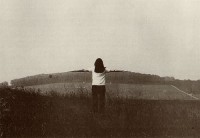BARBARA & MICHAEL LEISGEN
source: collectionfraclorraineorg
In the 1970s, the early works of Barbara & Michael Leisgen came as a counterpoint to conceptual photography, notably that of Bernd & Hilla Becher’s typology school of Düsseldorf. The series that the five Frac pictures are taken from belongs to practices operating since the early 1960s: the recording of a natural imprint, research into the body theme and experiments with Land art. Barbara Leisgen’s silhouette is set, and leaves its fleeting trace in landscapes; the actions involve stretching out her arms to follow the contours of undulating countryside (the Paysage mimétique and Mimesis series), or to include the sun in an arc drawn by her arm while she is seen from behind in the centre of the image (Die Beschreibung der Sonne – Description of the Sun_). While this last title, like a later one (_Writing of the Sun), harks back to the Greek etymology of the original ‘photograph’, the ‘heliography’ of Nicéphore Niepce, from ‘helios-graphein’, writing with the sun, it is conditioned by the human will framing it. This is not merely imitating nature through its gestures; it describes, in the sense of tracing, and channels it as well. The landscape is then repossessed in a subjective manner. Which is what inscriptions on tracing paper placed over the photographs of Paysage mimétique (Mimetic landscape) and Mimesis, la nature produit des ressemblances (Mimesis, nature produces likenesses) tend to produce, while the latter’s title explains the approach as being to start out from the bodily gesture. This somehow tames the natural elements, forcing them to follow the human. The pictures recall the visions of German Romanticism, notably the pictures of Caspar David Friedrich, whose painting Morgenlicht is the figurative model for the Mime-sis works, although his paradigm for considering nature as sacred is amended. One might see this as an anthropocentric romantic perspective such as the French Romantic view gave us. And yet, despite the sublime aspect of the photographed scenes and the preciousness of the prints which, beyond black and white, allow us to imagine a range of colours in the dazzling light, their images also refer back to the naivety and intrinsic nostalgia of souvenir photographs. The actual viewer is placed in a specular perception, being led to look at a woman posing in a natural expanse. In this the Leisgens are the precursors of current landscape approaches relying simultaneously on a modernist and postmodernist viewpoint, like the pictures of Torbjørn Rødland and Ilkka Halso.
.
.
.
.
.
.
.
source: dieemydarlingblogspot
‘Mimesis’ es el nombre de esta serie de fotografías que Barbara y Michael Leisgen, fotógrafos alemanes, tomaron en el año de 1972. Fotografías conceptuales en blanco y negro, donde los artistas tratan de experimentar con los paisajes, jugando con diferentes planos y logrando imágenes tremendamente sensibles con resultados bastante curiosos.
.
.
.
.
.
.
source: designplaygroundit
Le fotografie concettuali di Michael e Barbara Leisgen degli anni 70 mostrano Barbara che interagisce con i contorni della natura che pone di fronte a lei.
Il progetto Mimesis, deriva dai concetti filosofici di Platone sull’estetica:Riprendendo la tripartizione dei «letti», secondo Platone, ad essi corrispondono tre artefici: l’idea del letto è creata da un dio che crea le idee secondo natura (Demiurgo); il letto «fabbricato» è prodotto da un artefice (artigiano) che rivolge il proprio sguardo all’idea soprasensibile; quello «dipinto» è creato da un pittore che non si rivolge all’idea, bensì al letto sensibile fabbricato dall’artigiano, e quindi non può essere definito propriamente un artefice bensì soltanto un «imitatore» (mimetes).
Il pittore non imita dunque la realtà e la verità delle idee, ma l’apparenza delle cose sensibili, che a loro volta non sono che imitazioni delle idee: la sua è perciò «copia di una copia», imitazione di un’imitazione, ed per questo che si può affermare che egli produce «apparenze, non cose reali» e che può essere definito «imitatore dell’oggetto di cui gli altri sono artigiani».
Tuttavia, attraverso i suoi gesti, eseguiti in maniera molto semplice e coerente con le tracce del paesaggio che doma quasi a mimare la sua forma, Barbara riafferma il rapporto uomo / natura come due metà di un tutto.


